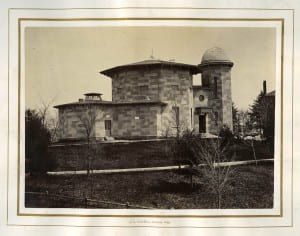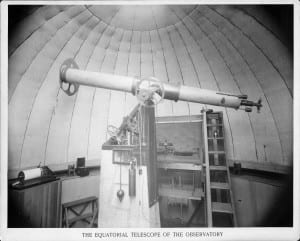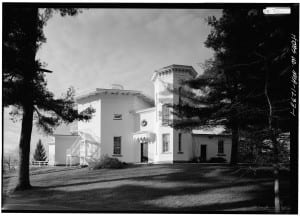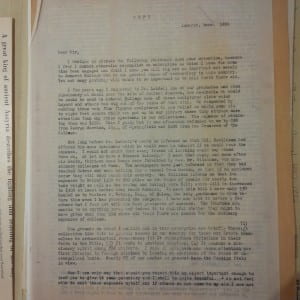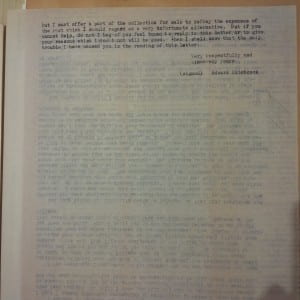Hitchcock was a patron of science, famous for his additions to geology and paleontology, but in another world, he would have looked into the stars instead of looking to the ground. This love of the stars and the sky did not dull after a bout of mumps harmed his eyesight during his teenage years. The astronomical world has entering a time of great development: the planet Neptune was discovered and the comet Haley amazed both scientists and onlookers of the 1840’s. This activity may have overturned Hitchcock’s proud logic – why not build an expensive scientific building in a time when the college could barely keep itself afloat, and a building so rare – “the observatories of the country might have been counted on the fingers of a single hand,” as says Professor Todd in “Early History of Astronomy at Amherst College.” On June 28th, 1847th, the building was dedicated “Lawrence Observatory” in honor of the highest donor to the fund for the Octagon, Abbott Lawrence.
“We have no telescope with which to grace the pedestal of the tower; but we should be very faithless and ungrateful to doubt that the same Providence which has done so much for us the past year, will send us a fitting telescope, if it be best for us to have one; and send it too just at the right time.”
– Rev. Edward Hitchcock, on the acquisition of an observatory and lack of a telescope during the dedication of the Woods Cabinet and Lawrence Observatory on June 28th, 1848
Five years later, Rufus Bullock donated $1,800 for a telescope, supposedly as a celebration of his son’s, Alexander Hamilton Bullock, admission into Amherst College’s Board of Trustees. The telescope bought was equatorial refractor, 7.25 inches from Alvan Clark & sons, and one of their first refractors. It was in use from 1852 to 1903, when a new observatory was built. The Lawrence Observatory quickly fell into disuse and by 1905 the Observatory was removed, leaving the current view of the flat-topped Octagonal tower.

At this point in Amherst College history, many of the graduates pursued missionary work, converting foreign peoples to Christianity. One such missionary who was working in Mosul, near the ancient city of Nimrod – Rev. Henry Lobdell – was contacted by Hitchcock about procuring a portion of the royal palace there. At that point, Williams College had already produced some; in response, Lobdell declared he would find even better specimens. Here is a transcript of a letter from Hitchcock about the process of procuring these slabs – known as
“the Nineveh Tablets” in Hitchcock’s time and as “the Assyrian Reliefs” currently.
The Nineveh Tablets in their initial location in the Woods 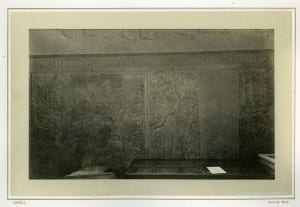 Cabinet. Enos Dickinson, a great relative of Emily Dickinson, donated the funds to present the Nineveh Tablets in the Cabinet. Both Lobdell and Dickinson are credited with the exhibition; in this photograph, the inscription reads:
Cabinet. Enos Dickinson, a great relative of Emily Dickinson, donated the funds to present the Nineveh Tablets in the Cabinet. Both Lobdell and Dickinson are credited with the exhibition; in this photograph, the inscription reads:
“The specimens below were obtained by Dr. Henry Lobdell of …”
The Assyrian Reliefs have moved from one place to another – for a little while they lived in Morgan Library, gracing library patrons, then art students, with their ancient presence. With the construction of the Mead Art Museum in 1949, the Assyrian Reliefs found a stable home in a museum setting. In 1925, they were valued at approximately $120,000 to $140,000 by “Mr. Von Der Osten, appraiser at the Metropolitan Museum” (the writer of a letter concerning this appraisal said that “if we ever have an art museum here, it will be a wonderful place to put these tablets”).
On March 6th, 2015, militants of ISIS bulldozed parts of the ruins of the ancient city of Nimrud. The curators of the Mead Art Museum were shocked at the news – so much debate over the reliefs has dealt with their place: either in their home country, or in an academic institution across the ocean. As of now, parts of the reliefs can be found in Williams, Dartmouth, Yale, Princeton, University of Pennsylvania, Union, and Bowdoin Colleges.
Read the full article here: (X)

